Artist in Residence Update: Being Weird in Flint
Editor’s note: Andrew Morton is a theater maker and one of our 2015-2016 artists in residence. As part of this program, artists in residence attend UMS performances to inspire new thinking and creative work within their own art forms. Andrew saw Taylor Mac’s performance. Below is his response to the show and to an artist-led workshop with his students at Flint Youth Theatre.

Flint Youth Theatre students with their creations, also with Andrew Morton and Machine Dazzle. Photo by Annick Odom.
While Taylor Mac’s A 24-Decade History of Popular Music was in Ann Arbor earlier this month, Machine Dazzle (Taylor Mac’s Costume Designer) came to do a workshop with some of my students at the Flint Youth Theatre. In preparation for the workshop with Machine, the students and I watched a couple of videos of excerpts from the 24-Decade project. During one of the videos, I was struck by what Taylor said about his interest in “imperfection fostering community.” Since the workshop with Machine and after seeing Act VII of the 24-Decade project a few weeks ago, I’ve been thinking a lot about this idea of imperfection.
When I first heard these words, naturally I immediately connected them to what is still happening in Flint with the ongoing saga of our water crisis.
Yes, we have some severe challenges ahead of us, but once again the resilience of this incredibly “imperfect” community continues to inspire me.
When Machine and some of the UMS team came to Flint to work with my students, it was just a couple of days after Snoop Dogg was handing out water in my friend’s neighborhood. The day before the workshop, I had a call from a friend who had just received a call from Macklemore’s people. They were looking for a space as he was also coming to Flint and wanted to meet with some young people. Now I hear Beyoncé is raising money for Flint during her next tour. That’s great. We need money, and a lot of it. But that’s not all we need.
Machine didn’t hand out water (or money) to the kids in my class, and we didn’t really talk about how the water crisis is affecting them. It is, and we already do talk about it, a lot. Instead, we made beautifully weird and wonderful costume pieces together. We talked about what inspired us to create, and how we can use our personal stories and experiences to create a piece of art.
Being weird
One of the things I love most about working at a place like Flint Youth Theatre is that it’s one of those places that attract the weird kids, the kids who probably have a horrible time at school and feel like they don’t have many places where they can truly be themselves. At our theatre, being weird is not something to be ashamed of. It’s something to be embraced. For the two hours Machine worked with us, we were reminded of how great it is to be weird, and how it’s even better when you have a community of people to be weird with, and to create with.
Later that week I attended Taylor Mac’s performance of A 24-Decade History of Popular Music: 1956-1986. I was already familiar with judy’s work (judy is Taylor’s preferred gender pronoun), but this was the first time I was able to see judy perform live, and I certainly hope it won’t be the last.
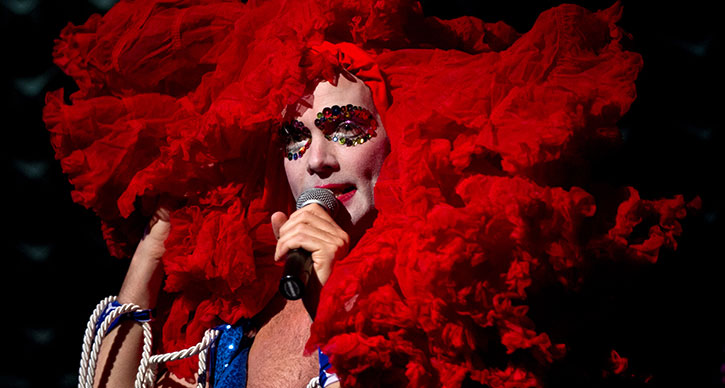
Taylor Mac performs. Photo courtesy of the artist.
I had been looking forward to this performance since late last year when I saw a production of judy’s play Hir at Playwrights Horizon in New York, arguably one of the best productions I saw in 2015. While very much a traditional play in its structure and form, it was unlike anything I had seen in a long time. The play celebrated the shift that is happening (albeit it very slowly) as we move away from the old world order (straight, conservative, hetero-normative) to a new one that is increasingly queer, progressive, and gender-fluid. Hir was about “smashing the patriarchy” and celebrating the formation of new communities based on shared ideas and experiences, and in many ways the 24-Decade project is doing the same thing. While I experienced Hir much like we experience the majority of western theater (as a mostly passive audience member sitting in the dark) the 24-Decade performance created an entirely different experience for its audience.
At the start of the evening, judy made it pretty clear that it was no surprise that a large portion of the audience was made up of people presumed to be mostly wealthy, privileged “Ann-Arbor types.” Judy even made some of those types stand up and move to either side of the theater, in an attempt to demonstrate the concept of white-flight. In a welcome act of solidarity with the community of Flint, judy also made a point to mention the water crisis and encouraged people to tweet or email our “tough nerd” governor about it. Naturally I did this with glee, and was pleased to see the reaction of many in the audience echoed mine.
Smashing patriarchy
Despite notable differences in the audience (the queers and the straights, the Flint or Detroit types and the Ann Arbor types, the rich and the not-so rich), community was formed during the shared experience that Taylor curated over those three fabulous hours. There was laughter, joy, probably a lot of confusion, and perhaps embarrassment on the part of some members of the audience who were roped into participating. I however was more than willing to help carry out a fellow audience member who represented a dead Judy Garland as Taylor sang Goodbye Yellow Brick Road.
I’m impressed by the ambitious nature of the 24 Decade project, and how judy is using performance and storytelling to build a new community, and to “smash the patriarchy” in American theater and in our culture at large.
This experience was a welcome reminder of how important it is to encourage weirdness, embrace imperfection, and help create community, and I’m thankful I get to do all of these things in a wonderfully weird and imperfect place like Flint.
Interested in more? Follow the adventures and process of other UMS Artists in Residence.
UMS Night School: Constructing Identity Together – Session 4 Recap
Please note: This post is a part of series about the free and open to the public UMS Night School. UMS Night School: Constructing Identity runs January 18-February 15, 2016.
This past Monday, I attended my second UMS Night School session. For this week’s session, we discussed this past weekend’s performances by Tanya Tagaq and Taylor Mac.
The discussion focused on how Taylor Mac and Tanya Tagaq made their performances accessible and relatable to audiences; some of the UMS Night School participants noted that Taylor and Tanya’s performances were “welcoming” and “inviting.” Talk about constructing identity together! These two artists really went above and beyond in engaging their audiences, whether it was physically (like Taylor Mac) or emotionally (like Tanya Tagaq), or both!
We then moved into a discussion of upcoming performance of Camille A. Brown’s Black Girl–Linguistic Play, occurring this Saturday, February 13, 2016 at 8 pm in the Power Center. This time around, the discussion was lead by guest speakers Robin Wilson (Associate Professor of Dance) and three University of Michigan students in the School of Dance: Michael Parmelee, DeeDee Fattore, and Selena Moeljadi, all of whom had the experience of being involved in Camille A. Brown’s City of Rain.
Camille A. Brown’s City of Rain, performed by the Mason Gross School of the Arts.
While the video above does not feature our awesomely-talented guest speakers, it does feature some of the emotion that our speakers said they’ve learned to channel in their performance of City of Rain, which was featured in the University of Michigan Dance Department’s most recent showcase, Momentum, which ran from February 4-7, 2016.
Robin Wilson shared her experience of what it was like to be the Rehearsal Director for City of Rain, while the students shared their experience of being in the midst of City of Rain.
What did you learn?
Jim asked the guest speakers what they learned from their experiences of City of Rain. Students mentioned “grief” and “sadness” in the physical movements that they experienced. They had to dig deep to successfully understand those (and other) emotions in the choreography. The students could’ve simply emulated the emotion that Camille A. Brown suggested, however, this would be similar to an instrumentalist emulating the emotion that a composer intended in a piece, or similar to an actor emulating emotions onstage. Sure, that might look and sound fine and dandy, but it would be different from the real thing. The real thing is when students draw upon their own grief, their own sadness, their own emotion to make Brown’s choreography much more powerful.
Robin Wilson, as Rehearsal Director, assisted in this process. She summed it up nicely: “We want a cake with the rum soaked through [not a cake with frosting on top]!”
Student DeeDee Fattore said that in her research she has found that she really loves that Brown’s work is so relatable; anybody – dancer or audience member – can relate to the movements and emotions in her work. Fattore says this is something that she would like to be able to do in her own work as a choreographer.
Black Girl – Linguistic Play
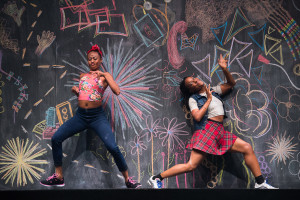 We shifted gears toward the end of the class to talk about Camille A. Brown’s Black Girl – Linguistic Play, which will be performed this Saturday, February 13, 2016 at 8 pm in the Power Center.
We shifted gears toward the end of the class to talk about Camille A. Brown’s Black Girl – Linguistic Play, which will be performed this Saturday, February 13, 2016 at 8 pm in the Power Center.
Asked what “Black Girl” really means, Wilson pointed out that it’s an important specificity. “Black” in this context is vernacular, being unapologetically oneself, and also implies that the work is perhaps intentionally less refined than and less conforming to the African American cultural identity. “Girl” in this context is associated with sass, playfulness, being yourself. Camille uses the title “Black Girl” to hone in on the identity and experience of being a “Black Girl.” Tickets to the performance are still available.
This session really pumped me up for the performance this weekend, and I walked out of the Alumni Center feeling inspired and full of new perspectives and insights.
I’m telling you, if you are looking to expand your horizons, these classes are amazing! There is only one session left, so join us next Monday, February 15, at 7 pm in the Alumni Center for Reflection and Graduation.
Taylor Mac Visits U-M Course
Taylor Mac visited the U-M Engaging Performance course last week:

Did you attend the performance? Don’t forget to share your thoughts.
UMS Night School: Constructing Identity – Session 3 Recap
Please note: This post is a part of series about the free and open to the public UMS Night School.UMS Night School: Constructing Identity runs January 18-February 15, 2016.
On Monday February 1, I attended my first UMS Night School session. For this particular week, we were lucky to have special guests Tanya Tagaq, performing February 2 at 7:30 pm, and Taylor Mac, performing February 5-6 at 8pm. The turnout for this session was high and the crowd was excited and interested to hear what the artists had to say in this casual yet upbeat interview.
Jim Leija (UMS Director of Education and Community Engagement) and Clare Croft (U-M Assistant Professor of Dance).
 Pictured from Left to Right: Clare Croft, Taylor Mac, Tanya Tagaq, Jim Leija
Pictured from Left to Right: Clare Croft, Taylor Mac, Tanya Tagaq, Jim Leija
Taylor and Tanya took turns talking about their upbringing. They were both expected to adhere to the social norms of their respective communities. At a certain point, both Taylor and Tanya were tired of being told to follow the rules and decided to rebel by branching out and letting their true identities be known. Taylor stated, “When I am on stage you listen to me, I am in charge!”
What is your artistic family tree?
Both Taylor and Tanya were influenced by music and other art forms at a very young age, and neither of them are classically trained musicians. Improvisation is important to both of them as performers, because it makes each show unique and special in its own way. Both artists use their performances as a way to connect with the audience in a profound way and always have an important message they hope to portray.
The floor was then opened up to audience questions. It was refreshing to learn that both Taylor and Tanya have changed over time as performers and to learn about what their ultimate goals were at a younger age as well as what they are now. As a student, I have sometimes been scared of becoming pigeon-holed into one career mindset when in reality there are multiple options and ways to achieve my ultimate goals.
The class was a fun and awesome learning experience; it was interesting to gain more perspective about different upbringings and lifestyle choices that people from vastly different regions can have.
UMS Night School sessions are free and open to the public. Drop into one or attend them all, no registration required.
Don’t miss the next class on Constructing Identity Together: Artists and Audiences with specials guests: Robin Wilson, Michael Parmelee, Daniele Fattore, and Salina Moeljadi, Monday February 8 at 7:00 pm.
What you can expect at Taylor Mac
Wondering what to expect from Taylor Mac? We asked his crew. See Taylor Mac in Ann Arbor Friday-Saturday, February 5-6.
Student Spotlight: Embedded with Taylor Mac and Pomegranate Arts
Editor’s note: As part of the UMS 21st Century Artist Internships program, four students interned for a minimum of five weeks with a dance, theater, or music ensemble part of our 2015-2016 season. Tsukumo Niwa is one of these students. This summer, he was embedded with the artist Taylor Mac and the production company Pomegranate Arts.
Below, Tsukumo shares her travel stories in New York City and beyond ahead of Taylor Mac’s performance in Ann Arbor on February 5, 2016.
This summer, through the UMS and U-M School of Music, Theatre & Dance 21st Century Artist Internship program, I had a chance to work closely with Taylor Mac and Pomegranate Arts in New York City.
A little bit about myself: I’m a junior majoring in Oboe Performance and International Studies. As such, theater arts – let alone drag performances – are a bit out of my specialty area. When I was first introduced to Taylor’s work, however, I was immediately intrigued by Taylor’s commitment to inclusivity, especially in terms of LGBTQ+ identities, and judy’s beautiful presence on stage with glittery and flashy costumes and make up. (Taylor uses “judy” as a gender pronoun.) Because I dedicate a lot of time to social justice education as well as music, I wanted to see how arts and social justice ideas can meet.

Taylor Mac performs. Photo courtesy of the artist.
International Festival of Arts & Ideas
The first week of internship, I attended my first Taylor performance at the International Festival of Arts & Ideas in New Haven, Connecticut. Held each year on Yale University campus, this festival brings in world-class artists and thinkers across genres. This festival commissioned the 1996-2006 decades of Taylor Mac’s 24-Decade History of Popular Music will eventually become an epic show performed over 24 continuous hours (in Ann Arbor, Taylor will focus on the 1960s, 70s, and 80s). The section at the festival was called “Songs Popular in the Radical Lesbian Circuit.” It was the opening performance.
On the day of the performance, six musicians, the company tour manager, and I took the Metro North together from Grand Central to New Haven. Some passengers noticed our gear, and asked if we’re musicians. Viva, the band’s “guitar goddess” interacted with her:
Viva: “Yes! We’re performing at Yale.”
Woman: “Cool, I might check it out! What kind of music?”
Viva: “It’s cabaret music from the 90’s.”
Woman: “Okay!”
Viva: “… popular with the radical lesbians.”
Woman: “…Oh.”
Viva: “You should totally come check it out!”
Woman: “Okay, I’ll try…?” *quickly escapes the scene*
While this woman wasn’t in our audience, we had a really good turnout, including donors in VIP seats with their jaws dropped as they experienced Taylor for the first time. We heard that one of the festival founders – a woman in her 80’s – attended the performance and left the house “glowing.” Almost everyone from Pomegranate Arts (the management company working with Taylor Mac) came to see the performance and to support Taylor. The support and reactions from the audience added to the energy of the performance by Taylor and judy’s band.
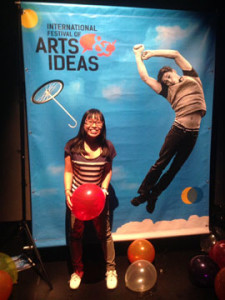
Me at the after-party, with performances by drag queens and dance music from the 90’s. It was fun!
Projects at the Pom Office
When I wasn’t at Taylor’s performances, I worked at the office of Pomegranate Arts, an independent management company that manages contemporary artists such as Sankai Juku and Philip Glass (both are familiar to the UMS audiences! Sankai Juku return this season October 23-24, 2015). With only 6 employees, it’s a small yet strong group that organizes shows and tours from start to finish.
With the help of my mentors, Linsey and Katie, I made a prototype of the project book for Taylor’s “A 24-Decade History of Popular Music.” Since “A 24-Hour History” is a huge project involving multiple parts, it’s necessary to keep them organized – costumes, stage directions, performance history, and song lists for each decade. Linda Brumbach, the founder and president of Pomegranate Arts, met with me to help me understand diverse topics what Pomegranate Arts is about, and what young artists like ourselves can do (watch for an interview soon!).
I also got to use my Japanese skills and helped to prepare visa documents for Sankai Juku company members. I can’t wait to finally see them in October!
Celebrate Brooklyn!
August 1, 2015 was the first time that Pomegranate Arts produced an outside show, and I was lucky to be a part of it. This was a huge one – 12 musicians on stage, 24 burlesque dancers strip teasing, and dozens of musicians from Brooklyn United Marching Band. About 2,000 people showed up for this free concert, ranging in age from toddlers to the elderly.

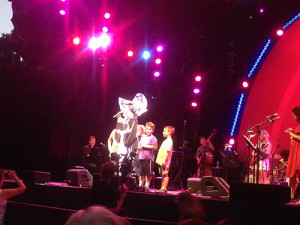
Photos: On left, my desk, with documents about “A 24-Decade History” project and project book on screen. On right, Taylor instructed these kids to (friendly) insult each other. The terrified look on their faces were priceless!
This was a huge day for me, too. As an intern, I was responsible for guiding all musicians and dancers backstage, hiring the videographer to film the rehearsal and mini interviews with artists, and just being available for anything the company needed. This was rewarding – I got to hear so many interesting stories from the musicians that have been working with Taylor for years, as well from as key people from Pomegranate Arts. One of my favorites was Machine Dazzle, the costume designer.
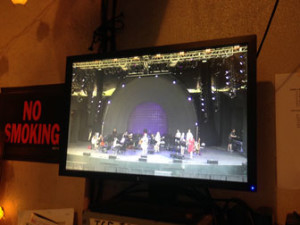
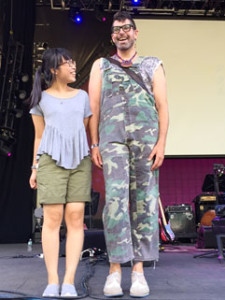
Photos: On left, dress rehearsal, seen through the backstage monitor. On right, Machine Dazzle, costume designer for Taylor Mac. He’s really tall. Or maybe I’m really short. Most likely both.
At this performance, a lot of things happened. Audience members were frequently brought to the stage and did various ridiculous things that Taylor asked them to do. They split up and shouted at each other, representing the pro-war and anti-war forces. The Brooklyn United Marching Band came on stage, 36 strong, and blew everyone in the crowd away.
Under Construction Series at the Park Avenue Armory
The final set of performances that I attended were totally different from the Celebrate Brooklyn! performance. They took place in the intimate and historic Park Avenue Armory, which accommodates artists that strive to create artworks that are difficult to present in traditional theaters and museums.
Since Taylor and Machine are resident artists at the Armory, they have access to one of the company rooms and store all the costumes and other materials related to “A 24-Decade History” project. It is really glittery, a bit messy, and awesome!
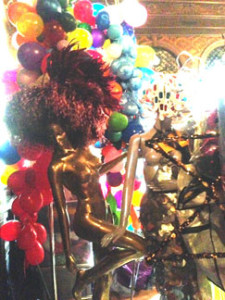
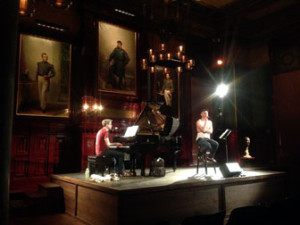
Photos: On left, just a few of the costumes living in the Armory! On right, the historic Board of Officers Room in the Armory. The walls are wooden, and acoustics are amazing for low-voice singer and piano! On piano is Matt Ray – the musical director.
There, they performed three decades that they have never performed before: 1776-1786, 1786-1796, and 1796-1806. Since these are near the dawn of US independence, many songs performed at these performances were patriotic. Taylor wore no costume for this performance; instead, some of the costumes were displayed stage-side so that the audience could imagine what this performance will look like as a finished work.
On the second night of this performance, during the “encore”, Taylor performed a song called “Pussy Manifesto” by Bitch and Animals from the 1996-2006 decade. During this song, he asks the audience to explore our various “pussies,” regardless of gender, in positive light. While Taylor asked the audience to explore our “mouth pussies” and sing the last phrase of the song, one audience member – a middle-aged man – showed strong discomfort. In response to this, Taylor said, “Whatever you’re feeling is appropriate,” meaning that audience members don’t have to necessarily like the performance. They could feel uncomfortable, disgusted, confused, or have any other emotion. Regardless of these emotions, as a theater artist whose art serves to challenge daily narratives, judy will have succeeded. This was quite a lesson for me.
Bringing This (Back) to Ann Arbor
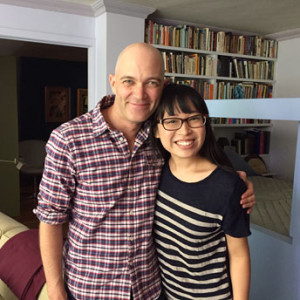 One of the biggest takeaways from this internship is that performances don’t always have to be perfect. Taylor calls judy’s performances “workshops,” implying that judy brings the performances closer to perfection through testing with the audience members. It takes courage to present something that you know isn’t perfect, and as a classical musician myself, I usually would not take this approach. However, now I feel more compelled than ever to show my imperfection, with the knowledge that I can get better with the help of audience and constructive feedback.
One of the biggest takeaways from this internship is that performances don’t always have to be perfect. Taylor calls judy’s performances “workshops,” implying that judy brings the performances closer to perfection through testing with the audience members. It takes courage to present something that you know isn’t perfect, and as a classical musician myself, I usually would not take this approach. However, now I feel more compelled than ever to show my imperfection, with the knowledge that I can get better with the help of audience and constructive feedback.
Speaking of audience, Taylor’s performances are full of audience interactions. Audience members can’t sit in their seats without doing something, whether it be manspreading, singing with Taylor and the band, or even sometimes slow-dancing with another audience member. Kids, elderly, moms, and LGBTQ+couples, and everyone in between get pulled to stage. Prepare to be challenged, and be comfortable being yourself.
Taylor Mac performs in Ann Arbor on February 5, 2016.
Interested in more? Explore more photo essays by students embedded with UMS artists.


